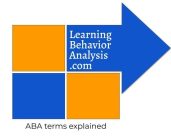D-4: Describe the advantages of single subject experimental designs compared to group design ©
Want this as a downloadable PDF? Click here!
Target terms (or phrases, in this case): single subject experimental designs, groups designs

Research is about asking and answering questions. It’s really important that the way we find an answer matches the question that was asked! That’s basically what research methods are all about.
It’s probably not helpful or productive to think of group designs and single subject designs as diametrically opposed in any philosophical way. They are two different ways of answering different kinds of research questions. Some people do feel that there are important and foundational divisions between the underlying assumptions of group designs and those of single subject designs. (This can be complex! Focus on learning the basics first.)
It’s important to note that “groups design” does not inherently refer to very large numbers of participants, nor does “single subject design” refer to studies that necessarily contain a single participant. The names refer to the level at which the analysis is conducted, not the absolute number of participants involved in the study. That being said, most single case studies do involve fewer participants than group designs.
Groups designs
Definition: Most people are familiar with research that involves two big groups of people. Researchers do something to group 1, and not group 2, and then they compare how both groups are doing (often by looking at an average of both groups) to see if the treatment made a difference. This is between subject research because the comparison is done (you guessed it) between different research subjects! (There is much more to between groups designs, of course. They are not simple. This is just a very, very basic overview of the main idea.)
Example in clinical context: Leonardo is in charge of assembling a team to evaluate the effectiveness of different reading programs on students who attend special education programs in major U.S. cities. The goal is to find out which program is most effective, so that the Department of Education can provide more targeted support to special education programs in urban areas. This research question is not about a particular individual. It is about which program is the best, on average, for urban special education students as a whole. This is a question that should be answered by assembling several very large groups of students, assigning them randomly to different programs, then comparing the dependent variables (in this case, reading scores) for each group. This design acknowledges that the results may not capture each individual’s experience. It is about what has the greatest impact on the dependent variable overall.
Why it matters: Between groups designs are not “bad,” nor do they yield inferior results when compared to within subjects designs. They simply provide answers to different questions, and those answers should be applied in different ways. It is important for behavior analysts to understand the basics of groups designs for several reasons, including the following: (1) most other fields, professionals, and stakeholders are more familiar with groups designs than with single subject methodology, and it is important to speak the same language when collaborating, (2) much of the broader conversation about “evidence based practices” in the helping professions are informed by groups research, and (3) a behavior analyst will probably encounter questions in their career that are best answered by consulting the between groups design literature.
Single subject experimental designs
Definition: Single subject experimental designs are different in several fundamental ways. The most obvious way is that comparisons are made within each subject. This kind of research design is therefore called within subjects research. The most obvious (and most experimentally weak) way to use an individual as their own control is to take data at baseline, then introduce an intervention and take data, and then compare the two sets of data to see if there is a difference. (See D-5 to explore more sophisticated ways to do this!)
Example in clinical context: DeShawn is in charge of selecting reading programming for special education students within an urban public school in the U.S. He knows that his students have different learning profiles and different learning contexts. DeShawn evaluates the relative benefit of multiple reading interventions at the individual level by conducting a multi-element design, and makes his decision based on how individual students respond to each intervention.
Why it matters: It is a foundational responsibility of behavior analysts to make decisions based on data and for the benefit of each individual client. Using single case design methodology helps us demonstrate a functional relationship between our intervention and the behavior change the client needs. At this point in human history, nothing can answer client specific questions regarding environmental interventions better than single subject methodologies. Pretty cool, right?
